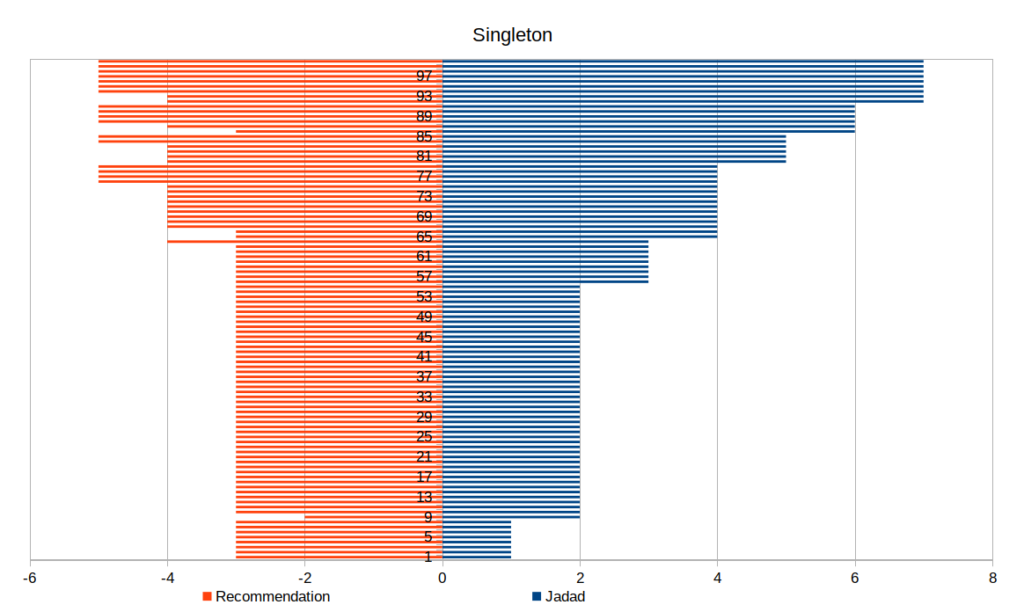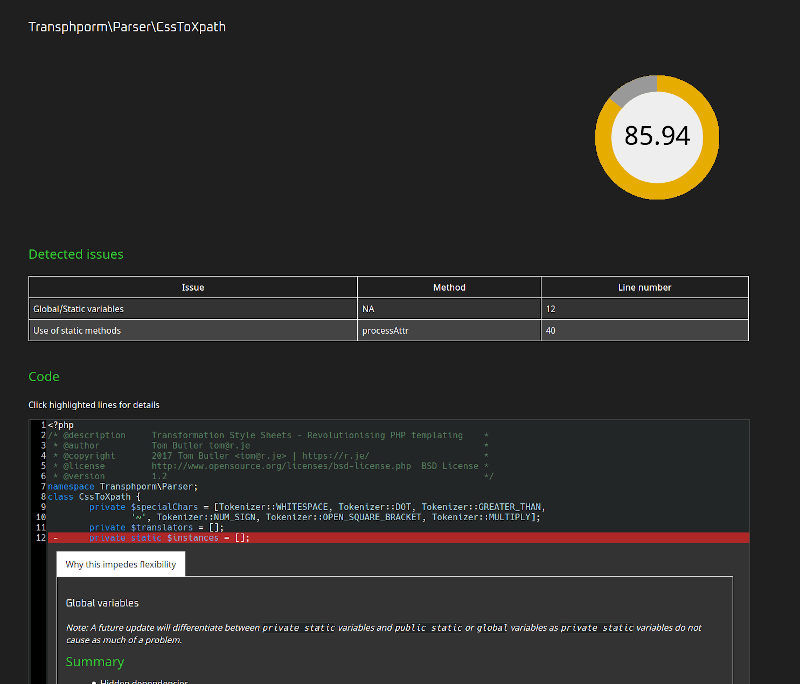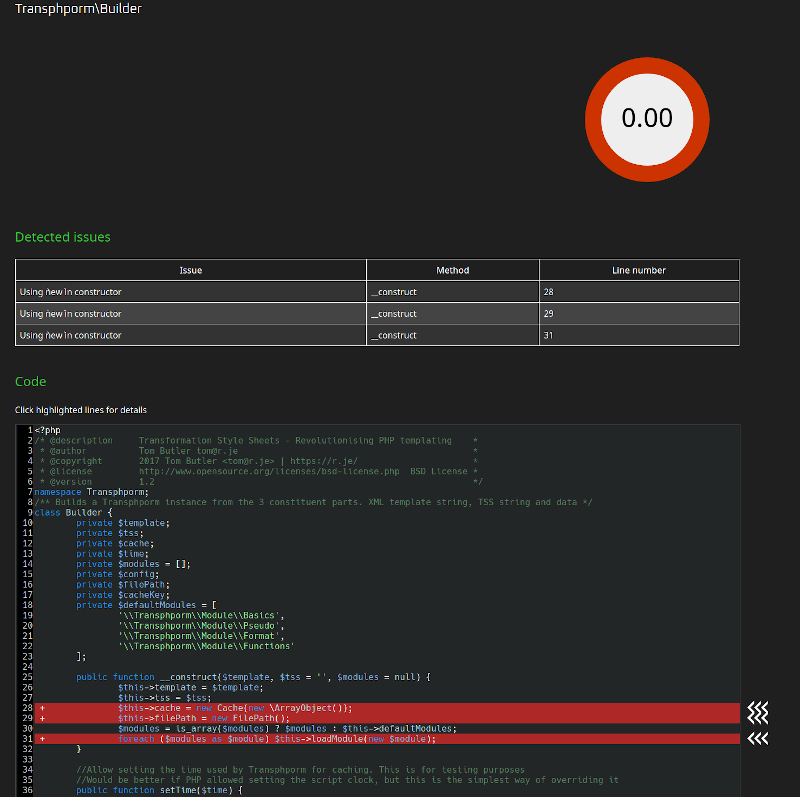Insphpect is a tool I wrote as part of my PhD project. It scans code for object-oriented programming techniques that hinder code reusability and flexibility.
Why?
Let me begin with two mundane observations:
- Business requirements change over time.
- Programmers are not clairvoyant.
New product launches, emergency lockdown regulations, expanding into new markets, economic factors, updated data protection laws: there are lots of potential causes for business software to need updating.
From those two observations we can infer that programmers know that the code they write is going to change, but not what those changes will be or when they will happen.
Writing code in such a way that it can be easily adapted is a skill that takes years to master.
You’re probably already familiar with programming practices that come back and haunt you. Novice programmers quickly realize that global variables are more trouble than they’re worth, and the once incredibly popular Singleton Pattern has been a dirty word for the last decade.
How you code your application has a big impact on how easy it is to adapt to meet new requirements. As you progress through your career, you learn techniques that make adapting code easier. Once you’ve grasped fundamentals of object-oriented programming you wonder how you ever did without it!
If you ask ten developers to produce software, given the same requirements, you’ll get ten different solutions. Some of those solutions will inevitably be better than others.
Consider a ship in a bottle and a model ship made of Lego. Both are model ships, but changing the sails on the ship in a bottle is very difficult, and reusing the parts is near impossible. However, with a Lego ship, you can easily swap out the sails or use the same components to build a model rocket, house or a car.
Certain programming techniques lead to the ship-in-a-bottle approach and make your code difficult to change and adapt.
Insphpect
Insphpect is a tool which scans your code for programming practices that lead to this kind of a ship in a bottle design.
It grades your code based on how flexible it is, and highlights areas where flexibility can be improved.
What does Insphpect look for?
Currently, Insphpect looks for the following:
- tight coupling
- hardcoded configuration
- singletons
- setter injection
- using the
newkeyword in a constructor - service locators
- inheritance
- static methods
- global state
- files that have more than one role (e.g. defining a class and running some code)
If it detects anything it identifies as inflexible, it highlights the code, explains why it highlighted the issue, then grades your whole project and individual classes on a score of 0-100 (with 100 being no issues detected). As a proof of concept, for some detections it’s able to automatically generate a patch file that re-writes the code to remove the inflexibility entirely.
Take a look a sample report here.
Insphpect is currently in the testing phase, and it would really help my research progress if you can check it out and complete the survey in the “Give your feedback” section of the site.
Background
Are those bad practices really bad, though?
This was one of the more difficult parts of the background research, and you can read about how this was done in detail on the Insphpect website.
However, this can be summarized as:
- The opinions of each bad practice were collected from 100 authors per practice.
- The author’s opinion on the practice was graded on a scale of 1–5.
- The author’s methodological rigor was graded on a scale of 1–7 based on the Jadad score used for clinical trials.
These were then plotted like the graph below:

Each horizontal line represents an article, and the left (orange) bar for each article is the recommendation going from 5 — Avoid this practice at all costs (Far left) — to 1 — Favor this practice over alternatives.
The right (blue) bar for each article is the Jadad style score measuring analytic rigor. A score of seven means the article describes the practice, provides code examples, discusses alternative approaches, provides like-for-like code samples, discusses the pros/cons of each approach and makes a recommendation of which approach should be used.
In the case of the singleton above, authors who compare the singleton to alternative approaches, discuss the pros/cons, etc., are significantly more likely to suggest using alternative approaches.
Walkthrough
Currently, Insphpect allows uploading code via a Git repository URL or a ZIP file.
So not to point out flaws in other people’s work, let’s take a look at one of my own projects to see what it identifies.
We’ll use https://github.com/Level-2/Transphporm as an example project.
This is quite a good example, because it has a very high score on another code-quality tool Scrutinizer.
Firstly, enter the git URL https://github.com/Level-2/Transphporm into the text box at the top of the home page and press “Go”. It will take a few seconds to minutes, depending on the size of the project, and will generate a report that looks something like this:

Once you’re on the report page, you’ll see a summary at the top with an overall grade out of 100, with 100 being very good and 0 being very poor.
Underneath the summary, you’ll see a list of all the classes in the project, each with its own grade.
Don’t worry if your code doesn’t get a perfect score. It’s unlikely that it will. Remember, Insphpect is a tool that identifies flexibility in your code. There are parts of your code (like the entry point) where flexibility isn’t warranted.
For Transphporm, it has highlighted issues in seven classes.
Let’s take a look at some of those. Scroll down to Transphporm\Parser\CssToXpath and click the link. You’ll see a score for that particular class and a list of issues which have been identified.
In this case, it has identified a static variable and a static method. Clicking on one of the red lines will reveal an explanation of why the line was flagged up.
For example, clicking line 12 will give an explanation of why static variables are less flexible than instance variables.

Although there’s a more in-depth explanation of the issues caused by static properties on the report, as a quick refresher, static variables have one value which is shared across all the instances of the class.
This is inherently less flexible than an instance variable, because using an instance variable allows each instance to have a different value.
For example, consider the following:
class User {
public static $db;
public $id;
public $name;
public $email;
public function save() {
$stmt = self::$db->prepare('REPLACE INTO user (id, name, email) VALUES (:id, :name, :email)');
$stmt->execute([
'id' => $this->id,
'name' => $this->name.
'email' => $this->email
]);
}
}
Because $db is static, every instance of this class shares the same $db instance and records will always be inserted into the same database.
While this sounds reasonable, let me give you a real-world example.
In the real world
One of our clients was a recruitment agency. About two years after we developed their site, they took over another smaller company. They wanted to retain the second company’s website and branding because it was quite well known in the niche they were in.
Our client asked us the following:
On the second company’s site, can you add a checkbox when adding a job that also adds the job to our database so people viewing our site can also see the job and visa versa.
A fairly simple request. Run an insert query into two different databases.
But because the website used a static global database instance, this was needlessly difficult!
The developers of that site wrote the code confident that only one database connection would ever be needed. They were wrong.
Remember, you’re not clairvoyant, and it’s impossible to anticipate what flexibility may be needed in the future.
The solution
As suggested by Insphpect, the solution to this is using instance variables:
class User {
private $db;
public $id;
public $name;
public $email;
public function __construct(\PDO $db) {
$this->db = $db;
}
public function save() {
$stmt = self::$db->prepare('REPLACE INTO user (id, name, email) VALUES (:id, :name, :email)');
$stmt->execute([
'id' => $this->id,
'name' => $this->name.
'email' => $this->email
]);
}
}
Now a User instance can be used with different database instances:
new User($database1);
new User($database2);
For Transphporm\Parser\CssToXpath we could do the same, remove the static variable and consider making it an instance variable rather than a static variable.
Using new in constructor
Let’s take a look at one of the other classes: Transphporm\Builder.

This has a score of zero, which is rather poor. Examining the report in detail, Insphpect has picked up the same issue three times: using the new keyword in a constructor.
Google Programming Coach Misko Hevery does a great job at explaining why this is a poor programming practice, but here’s a simple example from Insphpect’s output:
class Car {
private $engine;
public function __construct() {
$this->engine = new PetrolEngine();
}
}
Here, whenever an instance of Car is created, an instance of PetrolEngine is created. That makes it very inflexible, because there ’s no way to construct a Car with a different engine type. Every car modeled in this system must have a PetrolEngine.
Instead, we can use dependency injection:
class Car {
private $engine;
public function __construct($engine) {
$this->engine = $engine;
}
}
Different cars can be created with an instance of PetrolEngine, DieselEngine, ElectricEngine, JetEngine or any other engine type that exists in the project.
To fix this error in the Transphporm\Builder, all of the variables that currently have hard-coded class names should use constructor arguments instead.
There are other issues identified by Insphpect, but you can try it out for yourself and see how your project fares.
Behind the Scenes
You might be wondering how the scores are calculated and why this class got a zero. At the present time, the weightings are subject to change once more projects have been scanned and more feedback has been provided.
The scores are designed to be indicative for comparing one project/class to another.
The overall project score is just an average of all the classes in the project. This was implemented because a project with two issues in 1000 classes is a lot better overall than a project with two issues in two classes.
Each bad practice is weighted based on whether it impedes flexibility for the entire class or only impedes flexibility for a method.
Conclusion
Insphpect can be used to identify areas of your code which make future changes more difficult than they could be, and it offers suggestions on how to write the code in a more flexible manner. Remember, you’re not clairvoyant and have no way to know how your code is going to need to change!
Insphpect is currently a work in progress, and the more people who use it (and complete the survey) the better it will become.
How did your project or favorite library score? Be sure to complete the survey, as it will provide valuable data for my PhD project and help the tool improve!
Frequently Asked Questions (FAQs) about Ensuring Flexible, Reusable PHP Code
What are the key principles for writing reusable PHP code?
The key principles for writing reusable PHP code include following the DRY (Don’t Repeat Yourself) principle, using object-oriented programming (OOP), and utilizing PHP traits. The DRY principle encourages you to write code that can be used in multiple places, reducing redundancy. OOP allows you to create classes and objects that can be reused across different parts of your application. PHP traits are a mechanism for code reuse in single inheritance languages such as PHP.
How can I use PHP traits to write reusable code?
PHP traits are a set of methods that you want to use in another class. Traits are declared with the keyword ‘trait’ and can be used in classes with the ‘use’ keyword. They allow you to create reusable code units that can be inserted into different classes to share methods across them. This is particularly useful in PHP, which doesn’t support multiple inheritance.
What is the role of the PHP include function in reusable code?
The PHP include function allows you to include a PHP file within another PHP file. This is particularly useful when you have certain elements, such as headers, footers, or navigation menus, that are common across multiple pages. Instead of writing the same code on each page, you can write it once in a separate file and include it wherever needed, making your code more maintainable and reusable.
How can I ensure my PHP code is flexible?
Ensuring your PHP code is flexible involves writing code that can easily adapt to changes. This can be achieved by following good coding practices such as using clear and meaningful variable names, commenting your code, and organizing your code into functions or classes. Additionally, using design patterns can help make your code more flexible and easier to maintain.
What are some good practices for writing reusable and flexible PHP code?
Some good practices for writing reusable and flexible PHP code include following the SOLID principles, using design patterns, and writing unit tests. The SOLID principles are a set of design principles for writing maintainable and understandable code. Design patterns provide solutions to common programming problems and can help make your code more reusable. Unit tests ensure that your code works as expected and can help you identify and fix bugs early in the development process.
How can I use object-oriented programming (OOP) to write reusable PHP code?
Object-oriented programming (OOP) allows you to create classes and objects that can be reused across different parts of your application. A class is a blueprint for creating objects, and an object is an instance of a class. By encapsulating related data and behavior into a class, you can create objects from that class and reuse them wherever needed.
What is the DRY principle in PHP and how does it promote code reusability?
The DRY (Don’t Repeat Yourself) principle is a fundamental concept in programming that encourages you to avoid code duplication. In PHP, this can be achieved by encapsulating common functionality into functions or classes that can be reused. This not only makes your code more maintainable but also reduces the likelihood of introducing bugs.
How can I use design patterns to write reusable PHP code?
Design patterns are proven solutions to common programming problems. They provide a template for how to solve a problem that can be used in many different situations. Using design patterns can help make your PHP code more reusable, maintainable, and flexible. Some common design patterns used in PHP include the Factory Pattern, Singleton Pattern, and Observer Pattern.
How can unit testing help in writing reusable PHP code?
Unit testing involves testing individual units of code to ensure they work as expected. By writing unit tests, you can ensure that your code behaves correctly, making it more reliable and reusable. Additionally, unit tests can serve as documentation, showing how a particular function or class should be used.
How can I make my PHP code more maintainable?
Making your PHP code more maintainable involves following good coding practices such as using clear and meaningful variable names, commenting your code, and organizing your code into functions or classes. Additionally, following the SOLID principles and using design patterns can help make your code more maintainable. Regularly refactoring your code to remove redundancy and improve readability can also improve maintainability.
Tom Butler is a web developer and university lecturer. He has a PhD in the area of software engineering best practices and enjoys evaluating different approaches to programming problems.







